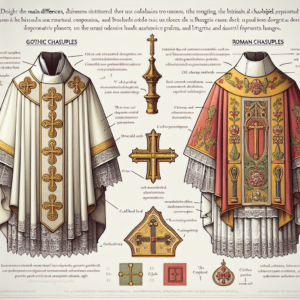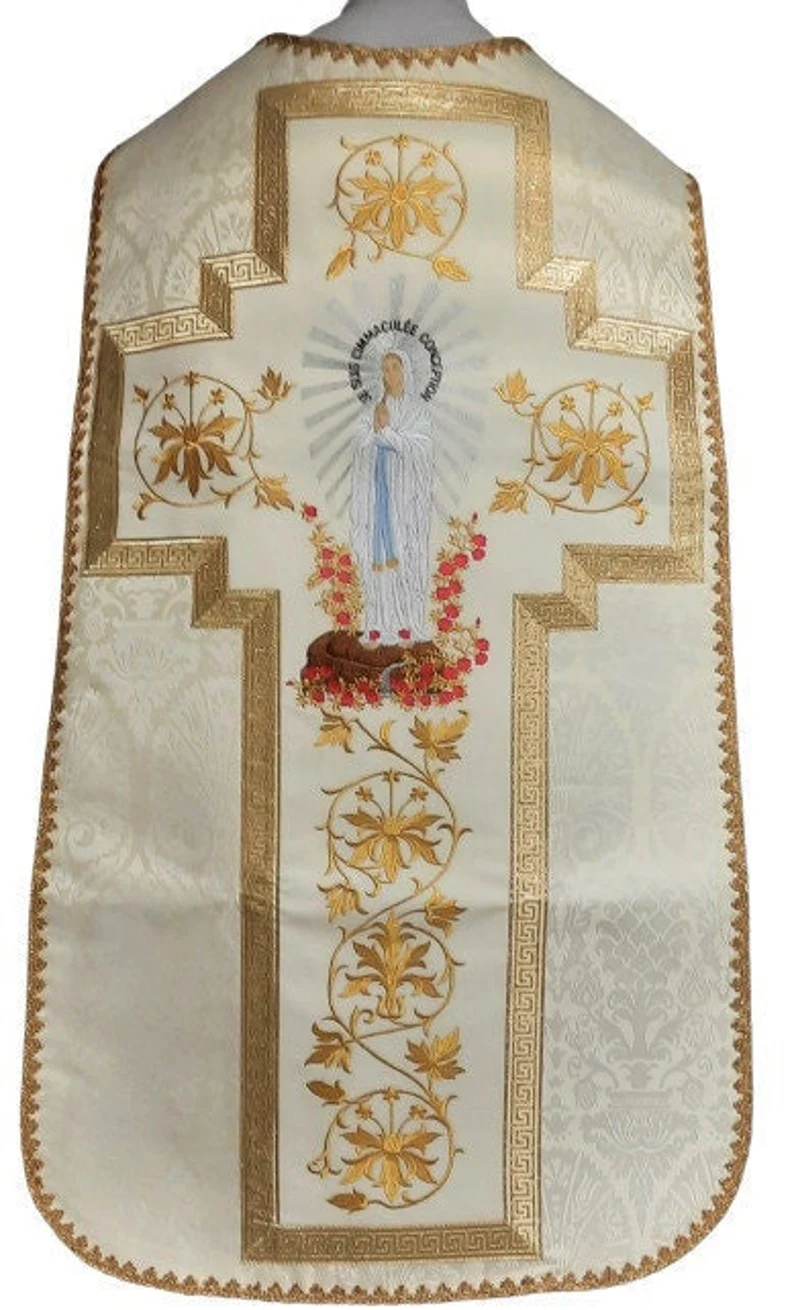Understanding the Distinction: Gothic vs. Roman Chasubles
When exploring the rich tapestry of liturgical vestments within the Catholic Church, one cannot overlook the significance of the chasuble.
This outermost liturgical garment, worn over the alb and stole by clergy during the Eucharist, has evolved through the ages, giving rise to two prominent styles: Gothic and Roman chasubles.
Let’s delve into the nuances that distinguish these two forms, tracing their historical roots and examining their symbolic meanings.
The Gothic Chasuble: A Flowing Tradition
The Gothic chasuble, known for its ample and flowing design, dates back to the medieval period. It was fashioned to allow for greater movement during Mass.
Its elongated oval shape, often extending to the wearer’s wrists, is a hallmark of this style.
The Gothic chasuble typically features a more elongated oval shape than its monastic counterpart and doesn’t have squared-off corners.
Orphreys, the decorative bands on vestments, are often seen in a column band in the front with a „Y”-shaped cross in the back.
This style is less richly decorated than the Roman chasuble and is more akin to modern chasubles.

The Roman Chasuble: A Symbol of Tradition
In contrast, the Roman chasuble, also known as the „fiddleback,” is characterized by its shorter and more tailored design.
It offers limited shoulder coverage and hangs in the front and back, often richly decorated with Christian symbols and made stiff and heavy with gold and brocade.
This style is most common in Traditionalist Catholic congregations.
The Roman chasuble is a minimalist design, elaborately decorated with embroidery, gold, and jewels due to the limited use of fabric.
Historical Evolution and Liturgical Significance
The evolution of the chasuble from its conical origins to the Gothic and Roman styles reflects changes in liturgical practices and aesthetic preferences over the centuries.
The Gothic chasuble’s fuller form is reminiscent of the garment’s original conical shape, which allowed for a wide range of motion.
The Roman chasuble, with its more form-fitting and ornate design, emerged as a response to the desire for a practical vestment for the celebrant rich in symbolism.

The Role of Vatican II and Liturgical Renewal
Following the Second Vatican Council, the liturgical renewal recognized the vestment as a symbol of the priest’s role and sought „noble beauty rather than mere sumptuous display.”
This led to a preference for the Gothic-style chasuble, considered more straightforward and aligned with the Council’s call for liturgically based vesture and ornamentation.
However, the Roman chasuble remains a cherished tradition within certain circles, reflecting a diversity of tastes and customs within the Church.
Frequently Asked Questions About Chasubles
What are the main differences between Gothic and Roman chasubles?
Gothic chasubles are more elongated and flowing, allowing for more significant arm movement, while Roman chasubles are shorter, stiffer, and more ornate, with limited shoulder coverage.
Why did the Gothic chasuble become preferred after Vatican II?
The Gothic chasuble was seen as a return to a simpler, more liturgically focused vestment that aligned with the Council’s emphasis on noble beauty and active participation in the liturgy.
Can both Gothic and Roman chasubles be used in the same liturgical setting?
Yes, both styles can be used in various liturgical settings, and the choice often comes down to the celebrant’s preference and the customs of the parish or diocese.
How has the design of chasubles evolved?
Chasubles have evolved from the conical shape of the early Church to the more tailored Roman and fuller Gothic styles, reflecting changes in liturgical practices and aesthetic preferences.
Are there any restrictions on the use of certain chasuble styles?
There are no strict restrictions on chasuble styles, and clergy may choose the style that best fits their liturgical and aesthetic preferences.
In summary, the Gothic and Roman chasubles represent two distinct traditions within the Catholic Church, each with its historical roots and liturgical significance. Whether one prefers the flowing grace of the Gothic style or the rich symbolism of the Roman „fiddleback,” these vestments continue to be powerful expressions of faith and heritage in celebrating the Eucharist.
